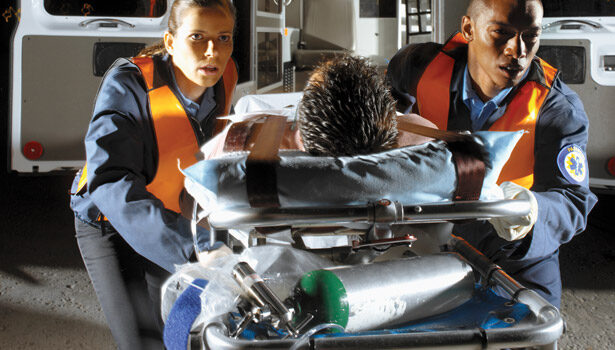Said ASSE President Terrie S. Norris: “The fact that this nation’s fatalities are not significantly decreasing should be a call for action… especially at an economically challenging time when some of the most dangerous industries are not at full employment… This nation’s effort to protect workers is stalled… A politically charged yes and no conversation about occupational safety and health… leaves too many of this nation’s workplaces mired in efforts that do not achieve better safety.”
100+ amputations each week
Outrage indeed. But job fatalities, in all their tragedy, don’t tell the full unacceptable story. Cases of very serious workplace injuries, severe enough to require days away from work to recuperate, totaled more than one million in 2009, according to the BLS. To be precise: 1,238,490 cases. That includes more than 100 amputations every week (5,930 total). More than 90 potentially disfiguring chemical burns per week (4,740 total). Almost 750 multiple traumatic injuries a week (38,820). Almost 300 assaults and violent acts (15,450 total). And more than 2,000 serious injuries occurred each week damaging multiple body parts.
Overall, BLS reported lost-workday cases declined nine percent in 2009; not a surprise given continuing high unemployment, especially in the risky construction business. But forget about trend lines. The number of workers dying on the job or severely injured, what this month’s cover story refers to as serious injuries and fatalities, or SIFs, points to a crisis of leadership. It is not understood by the public, the media, or lawmakers. Some employers are rattled, worried and wondering what to do about SIFs as a result of first-hand encounters. But too many remain ignorant, either out of luck, denial or lousy tracking systems.
The Associated Press reported in September that at least 1,645 members of the U.S. military had died in Afghanistan since the U.S.-led invasion in 2001. Since the start of U.S. military operations in Afghanistan, 13,609 U.S. service members have been wounded in hostile action, according to the Defense Department. This has sparked intense, passionate debate in Washington and around the country. What are these men and women dying for? Can it be justified?
Walls of silence
As you too well know, no questions are being raised, except in some traumatized companies, about what men and women in the workplace are dying and being seriously wounded for, and why. As ASSE and our cover story point out, absolutely no acceptable reason for it exists. There are, though, unacceptable ones: widespread overreliance on superficial OSHA recordkeeping figures. Underfunding of safety and health departments. Downsizing of safety and health staff. The safety profession’s profound lack of research. Its fragmentation and turf battles. And its everlasting embrace of the venerated Heinrich Safety Laws. Founded more than 80 years ago by a well-intentioned insurance man, H.W. Heinrich, they posited, among his more valid theories, that minor injuries are predictive of SIFs, which they are not according to more recent studies, and most accidents are caused by “man errors,” which today translates into “blame the victim.”
An untold toll
Yet another widely untold story reaches beyond the deaths on the job, violent assaults, amputations, chemical burns and the other hundreds of thousands of traumatic injuries every year. It is the mental trauma of co-workers who are eyewitnesses to grisly deaths and gruesome injuries.
Much has been reported of late about post-traumatic stress disorder (PTSD). Much of the coverage of course relates to shaken survivors of the Iraq and Afghanistan wars. And PTSD was a storyline in coverage of the tenth anniversary of the 9/11 attacks.
In August, 2002, a study published in The Journal of the American Medical Association suggested more than one in ten New York-area residents suffered lingering stress and depression in the aftermath of the attack on the World Trade Center. Conducted two months after the attacks, the research estimated 9/11 resulted in an extra 532,240 cases of PTSD. “The strongest predictor of PTSD symptoms was direct exposure — being in the World Trade Center that day,” said one of the researchers. “But we also show that there is an important association between PTSD and having a friend, family member, or co-worker killed in the attack.”
In February of this year, a new study by the New York City Department of Health and Mental Hygiene estimated approximately 15 percent — or about 355 — of the 3,271 people surveyed likely had a chronic case of PTSD two-to-three years following 9/11. Ninety-five percent reported having at least one symptom attributable to PTSD relating to the attacks.
PTSD has also emerged as an issue in the wake of weather disasters dating back to Hurricane Katrina. A search of NIOSH’s website (www.cdc.gov/niosh) turns up 157 reports and references to PTSD. One report, from the U.S. Bureau of Mines, is titled, “A human component to consider in your emergency management plans: the critical incident stress factor.” Other PTSD literature focuses on emergency response workers, the effects of disasters on workers, police, firefighters, miners and healthcare workers.
To my knowledge, no research exists on PTSD relating to workers in construction, manufacturing or energy industries who have been associated with a job site disaster, fatality or serious injury, or the PTSD effects on families and friends of workers killed or maimed on the job. This void is no excuse for any business’s executive leadership and safety and health leadership to neglect or dismiss the potential for PTSD after traumatic shocks. Too much is known today about PTSD. Just search NIOSH’s web site. Or Google PTSD.
Symbols of psychic scars
Here is some of what you’ll learn, if you don’t already know:
- Most people who go through a traumatic event have some symptoms at the beginning but don’t develop PTSD, according to WebMD.
- Bad memories of the traumatic event can come back at any time.
- Some people may keep very busy or avoid seeking help. This keeps them from having to think or talk about the event.
- PTSD can cause people to: suddenly become angry or irritable; have a hard time sleeping; have trouble concentrating; have difficulty controlling emotions; exhibit self-destructive behavior such as excessive boozing or smoking; feel emotionally numb; be easily startled or frightened.
- PTSD symptoms can come and go. People may have more symptoms when things are stressful in general, or when encountering reminders of what they went through.
- If someone has PTSD symptoms for more than a month, if they’re severe, or if they feel they’re having trouble getting their life back under control, they should talk to their health care professional. Getting treatment as soon as possible can help prevent PTSD symptoms from getting worse, according to WebMD.
“Ten months out it is very clear. If people still have even partial PTSD they will feel bad for months or years if they don’t get help,” Randall Marshall, MD, director of trauma studies at the New York State Psychiatric Institute at Columbia University, told WebMD. “It is a real disorder with real brain alterations. It is not in your head. It is certainly not the moral failing many people feel it is.”





